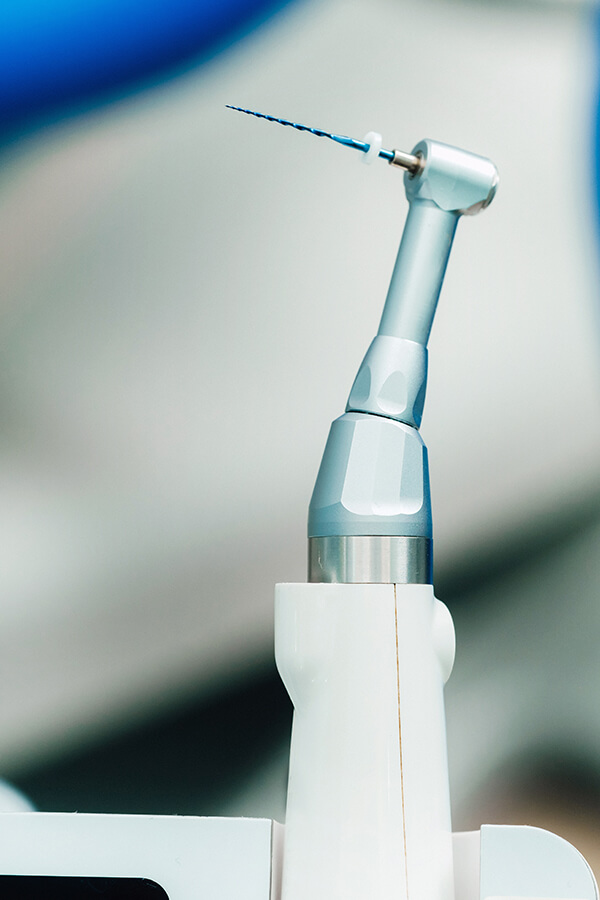Root Canal
Need a Root Canal or Treatment?
At Southridge Dental, we've got your back!
Root canal treatment is necessary when the pulp (soft tissue inside your teeth containing blood vessels, nerves and connective tissue) becomes inflamed or diseased. During root canal treatment, your dentist or endodontist (a dentist who specializes in treating the insides of teeth) removes the diseased pulp. The pulp chamber and root canal(s) of the tooth are then cleaned and sealed. If the infected pulp is not removed, pain and swelling can result, and your tooth may have to be removed.
Causes of an infected pulp could include:
- a deep cavity
- repeated dental procedures
- a cracked or broken tooth
- injury to the tooth (even if there’s not a visible crack or chip)
- If you continue to care for your teeth and gums your restored tooth could last a lifetime. However, regular checkups are necessary; a tooth without its nerve can still develop cavities or gum disease. Most of the time, a root canal is a relatively simple procedure with little or no discomfort involving one to three visits. Best of all, it can save your tooth and your smile.

Dispelling a "Root Canal" Myth
Typically, we will use a local anesthetic to numb the area around the tooth and inside the tooth. If you tooth is severely infected, it may take a bit for it to become fully numb, but we won’t start working on you until it is .. this is a pretty painless procedure.
We drill a hole in your tooth to allow us access to the pulp chamber and root canals for treatment. The diseased and dead pulp tissue is removed from the tooth with specially designed instruments used to clean out the root canals and pulp chamber. This is not painful; the area is numb and the tissue being removed is either dead or dying. Once the pulp, along with the nerves contained in it, is removed, the tooth itself can no longer feel pain.
We then clean, medicate, disinfect the canals with antiseptic and antibacterial solutions. The root canals are then “sealed” – filled with root canal fillings. A temporary or permanent filling material will be used to protect the outer surface of your tooth and seal the hole we used so access the pulp chamber and root canals.
Depending on the severity, antibiotics may be prescribed as well as pain medication. To kill any infection and provide comfort following your root canal. It is normal to have 3-5 days of some discomfort from this procedure.
Eventually, your tooth may need a permanent crown to replace any tooth structure lost during the procedure or prior to treatment.
Just remember a root canal is going to relieve your pain, not increase it, and will make for a healthy tooth for the rest of your life.
What is a Root Canal?
Invisalign® Invisible Braces
To keep it simple, a root canal removes soft infected tissue from the root canals of your tooth. A space inside the tooth called the “pulp chamber” houses the root canal system and pulp — the living tissue that keeps the tooth alive. The pulp includes blood vessels, nerves and connective tissues, and, during childhood, creates the surrounding hard tissues of the tooth.
Endodontic treatment (“endo”=inside; “dont”=tooth), commonly known as root canal treatment, is needed when the pulp becomes inflamed or infected. The causes could be deep tooth decay, repeated dental procedures on one tooth (replacing a large filling, for example), or traumatic damage such as a crack, chip or even a root fracture. Gum disease can also give rise to root canal problems necessitating root canal treatment.
Any of these issues can result in acute inflammation of the pulp, which causes swelling and pressure inside the tooth (that has nowhere to go), leading to tooth pain and, eventually, irreversible damage to the pulp. This is a very painful condition, very similar to an abscess, and can cause pain in the soft tissue of your cheek and face, headaches, pains shooting down your neck, etc., in addition to the actual severe pain of the infected tooth itself.
This is exactly “why” you need to see your dentist on a regular basis for exams (minimum 2 times a year) so that exams can catch these problems early, before they become severe (except in case of injury).
General Root Canal Treatment
Typically, we will use a local anesthetic to numb the area around the tooth and inside the tooth. If you tooth is severely infected, it may take a bit for it to become fully numb, but we won’t start working on you until it is .. this is a pretty painless procedure.
We drill a hole in your tooth to allow us access to the pulp chamber and root canals for treatment. The diseased and dead pulp tissue is removed from the tooth with specially designed instruments used to clean out the root canals and pulp chamber. This is not painful; the area is numb and the tissue being removed is either dead or dying. Once the pulp, along with the nerves contained in it, is removed, the tooth itself can no longer feel pain.
We then clean, medicate, disinfect the canals with antiseptic and antibacterial solutions. The root canals are then “sealed” – filled with root canal fillings. A temporary or permanent filling material will be used to protect the outer surface of your tooth and seal the hole we used so access the pulp chamber and root canals.
Depending on the severity, antibiotics may be prescribed as well as pain medication. To kill any infection and provide comfort following your root canal. It is normal to have 3-5 days of some discomfort from this procedure.
Eventually, your tooth may need a permanent crown to replace any tooth structure lost during the procedure or prior to treatment.
Just remember a root canal is going to relieve your pain, not increase it, and will make for a healthy tooth for the rest of your life.


